Your brain is a powerhouse of activity, processing, and storing information around the clock. It’s also susceptible to a number of different inflammatory triggers that can lead to chronic feelings of malaise, fatigue, and general mental fog. Acupressure for brain inflammation can help!
While inflammation affects all areas of the body, it poses a particular problem for your brain by damaging nerve cells and disrupting communication between neurons.
Thankfully, there are some strategies that you can use to help prevent or manage brain inflammation. For example, eating a healthy diet full of fruits and vegetables can provide your brain with key nutrients that support the health of neural pathways and restore vital energy.
In addition to conventional treatments, Traditional Chinese Medicine offers natural cures like acupressure and acupuncture treatment that can promote overall brain health.
First, you’ll need to know the acupuncture points to reduce brain inflammation and promote blood circulation.
Acupoint: GB-20 (Other Names: Gallbladder-20/Feng Chi/Wind Pool)
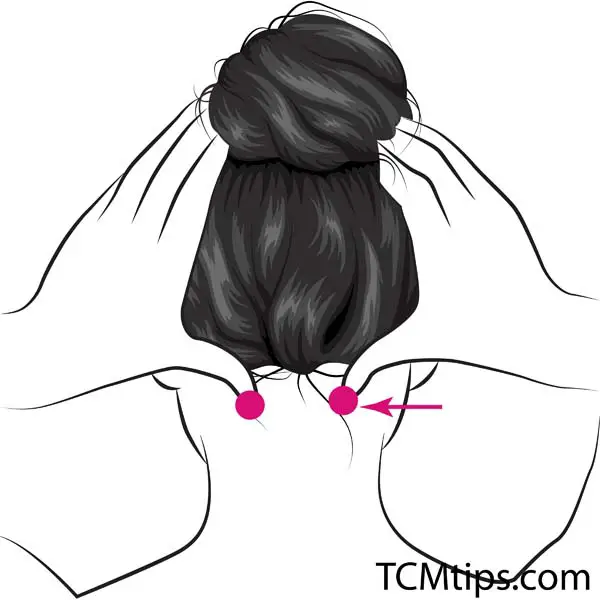
The acupoint GB-20 is known as “Fengchi” which means “Wind Pool”. GB-20 is situated on the nape, below the occiput, in the depression between the top section of the sternocleidomastoideus and the trapezius muscles.
It is classified as the Crossing point of the Gall Bladder Meridian and the Yang Wei blood vessel. This acupressure point dispels exterior and interior Wind, clears the mind, helps the eyes, nose, and ears, restrains Liver Yang, stimulates the energy flow, and reduces chronic pain.
GB-20 serves as one of the acupuncture points to reduce brain inflammation and can be used for treating:
– a common cold
– nasal congestion
– headache
– redness
– puffiness
– pain in the eyes
– runny nose and epistaxis
– stiffness and discomfort in the neck
– shoulder restriction
– drowsiness, vertigo
– hemiplegia
– epilepsy.
Those suffering from migraine benefit greatly from acupuncture. The acupressure brain inflammation point GB-20 is one of the acupressure autoimmune inflammation and acupuncture points for relaxation. It is widely used as natural painkillers to alleviate migraines, help with pain reduction, and reduce the use of pain medications.
According to a study published in 2020, electroacupuncture at Fengchi (GB-20) improves traumatic neuritis following intracerebral hemorrhage and slows the formation of perihematomal cerebral edema.
Another rat model experimental study concluded that electroacupuncture at GB-20 reduces inflammatory factors and is one of the effective treatments against migraine.
Acupoint: ST-36 (Other Names: Stomach-36/Zu San Li/Leg Three Miles)
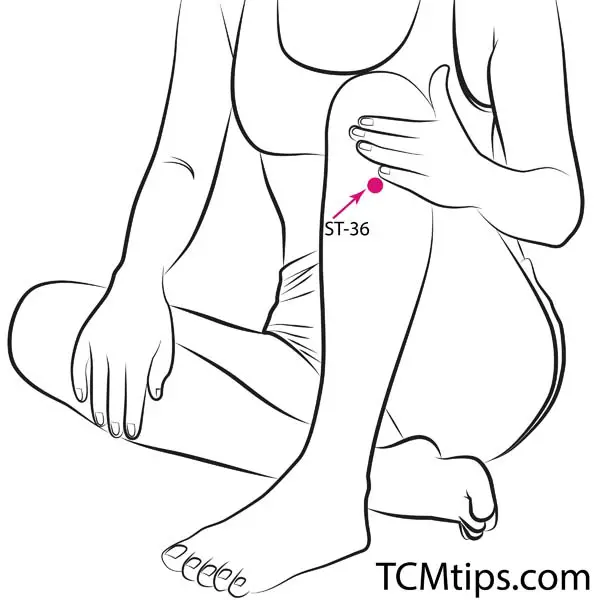
The acupoint ST-36 is known as “Zusanli” which means “Leg Three Miles.” ST-36 is situated on the anterior aspect of the lower leg, 3 cun below ST 35, one finger-breadth (middle finger) from the anterior crest of the tibia.
ST-36 harmonizes and strengthens the Spleen and Stomach, tones Qi and Blood, fortifies the body and Wei qi, elevates Yang, soothes the Shen, stimulates the blood flow, and helps with pain reduction. This acupressure brain inflammation point can help with conditions like:
– Abdominal distention and pain
– Diarrhea
– Dysentery
– Severe mastitis
– Palpitations and breathlessness
– Low appetite
– Dizziness
– Sleeplessness
– Asthma and cough
– Knee pain

ST-36 is an acupoint that has been widely utilized for brain diseases and is one of the acupoints used for stroke treatment. Acupressure brain inflammation point at Zusanli (ST-36) is frequently used to aid motor recovery following a stroke or traumatic brain injury and to improve motor cortical stimulation, and help with pain reduction.
According to a review article, numerous researches have reported that acupuncture stimulation at ST-36 appears to increase adult neurogenesis. According to one study, acupuncture and electroacupuncture significantly reduced infarct size and enhanced neurological function. ST-36 is also one of the acupressure points for lower abdominal pain.
Acupoint: KI-3 (Other Names: Kidney-3/Tai Xi/Supreme Stream)
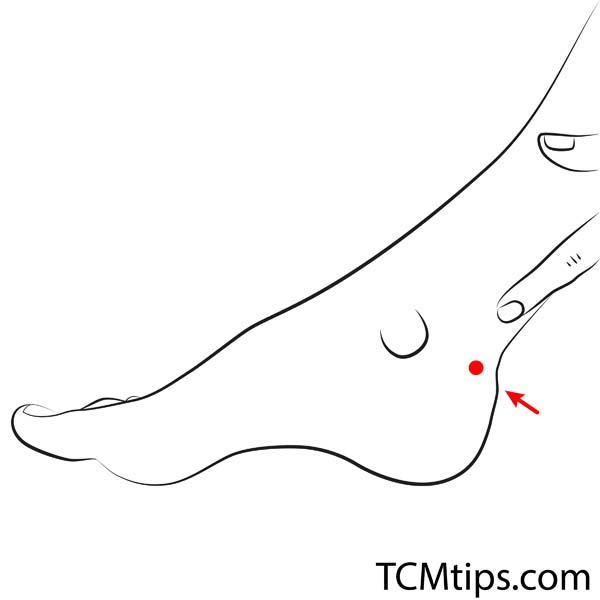
The acupoint KI-3 is known as “Taixi” which means “Great Stream”. KI-3 is situated in the depression between the tip of the medial malleolus and the tendon calcaneus on the medial part of the foot, posterior to the medial malleolus.
KI-3 is classified as the Yuan-Source point of the Kidney Meridian, Shu-Stream point of the Kidney Meridian. Acupressure brain inflammation point KI-3 tones the Kidneys (Yin and Yang), strengthens the lower back, and alleviates heel and ankle discomfort.
It can help with
– infertility
– spermatorrhea
– frequent urination
– deafness, tinnitus
– irregular menstruation and menstrual cramps
– lumbar discomfort and muscle pain
– headache
– dizziness
– blurred vision
– dental pain
– pharyngeal swelling
– cough and asthma
– diabetes
– insomnia
According to a 2020 study, acupuncture at KI-3 has both immediate and long-term effects on blood pressure, notably systolic blood pressure.
Extracerebral areas involved in vision, motor control, cognition, and hearing were engaged, which may help to reduce hypertensive problems in individuals with severe illness. The results of a research gave a reference for acupoint selection and combination in clinical acupuncture therapy for Alzheimer’s disease, including acupoint KI-3.
A study concluded that electroacupuncture treatment at bilateral KI-3 improves cognitive impairment in a mouse model of Alzheimer’s disease by inhibiting synaptic degradation and neuroinflammation. KI-3 is also used in acupressure for back inflammation and serves as one of the kidney meridian points.
Acupoint: GV-20 (Other Names: The Governing Vessel-20/Bai Hui/Hundred Convergence)
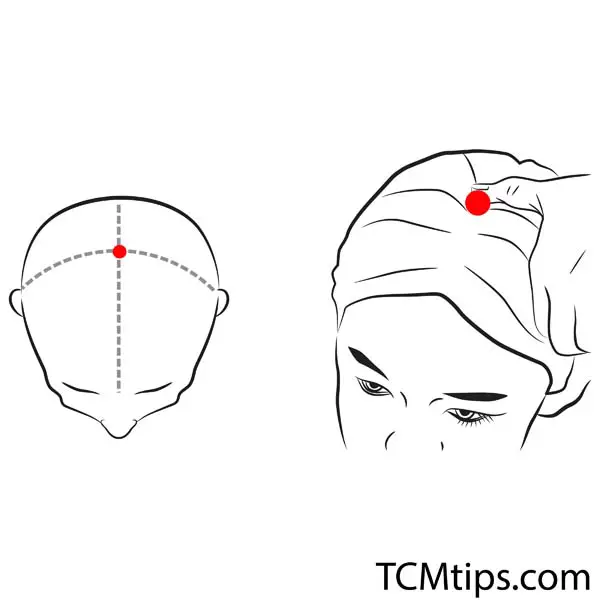
The acupoint GV-20 is known as “Bai Hui” which means “Hundred Convergences” GV-20 is situated 7 cun just above the posterior hairline, about on the midpoint of the line connecting the apexes of the two auricles.
This acupoint clears the mind, lifts the spirits, tones yang, strengthens the Spleen’s ascending function, eradicates interior wind, and helps promote resuscitation.
It is one of the important acupuncture points to reduce brain inflammation and is useful in conditions such as:
– headache
– vertigo
– tinnitus
– nasal blockage
– apoplexy-induced aphasia
– coma
– mental problems
– rectum and uterine prolapse
Acupoint GV-20 is one of the most important acupoints on government vessels and throughout the meridian acupoint system. This acupressure brain inflammation point is used to treat conditions like headaches, strokes, dizziness, and anxiety.
According to a 2014 study, Baihui (GV-20)-based scalp acupuncture could improve infarct volume and neurological function score, as well as play a potential neuroprotective role in experimental ischemic stroke.
Another experimental research concluded that laser acupuncture at GV-20 reduces brain infarct volume in cerebral ischemic mice. GV-20 is also one of the important acupressure points for anger.
Acupoint: LU-10 (Other Names: Lung-10/Yu Ji/Fish Border)
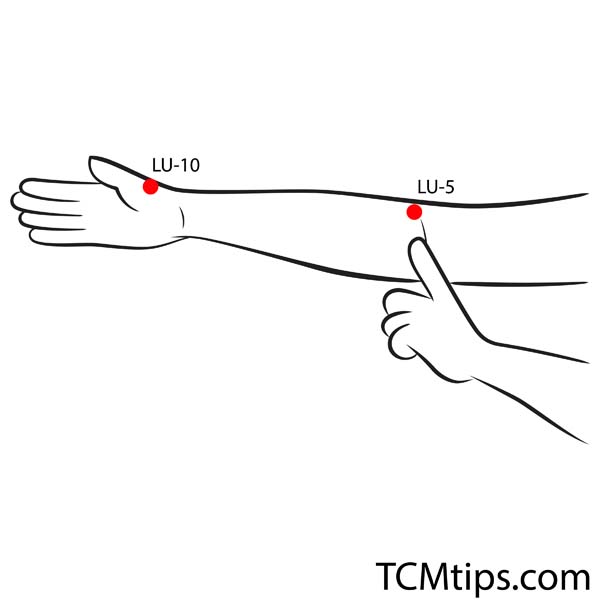
The acupoint LU-10 is known as “Yuji” which means “Fish Border”. LU-10 is situated in the dip behind the thumb’s thenar eminence, around the middle of the palmar side of the thumb, at the intersection of red and white skin.
Acupoint LU-10 is classified as the Ying-Spring point of the Lung Meridian. This acupoint clears Lung Heat and benefits the throat. Pressed firmly for 3 to 5 minutes, the LU-10 is useful in a variety of conditions such as asthma, sore throat, fever, hoarseness, cough, and hemoptysis (coughing blood).
Acupuncture is characterized as a treatment for acute traumatic brain injury, with effects on neuroinflammation, intracranial edema, oxidative stress, and neuronal regeneration.
According to one study, acupuncture at Yuji (LU-10) acts on asthma alleviating acute attacks of bronchial asthma and has a speedy effect.
According to another study published in 2015, Transcutaneous Electrical Acupoint Stimulation was shown to be a safe and effective therapy to reduce muscle stiffness after brain injury. LU-10 is also used as a pressure point on the thumb for heart attacks.

Try our Anti-Aging Gua Sha Tool designed to bring out your skin’s natural glow.
Best Gua Sha Product- Anti-Aging: The tool is designed to target 11 specific aging signs such as wrinkles and sagging skin. By following the 7-step routine, users can improve skin firmness and reduce fine lines naturally.
- Enhances Skincare Routine: It works effectively with serums and lotions, boosting absorption and efficacy of skincare products.
- Visible Skin Improvement: Users can expect a smoother complexion, reduced puffiness, and a more youthful appearance.
 P. Sze
P. Sze 
















